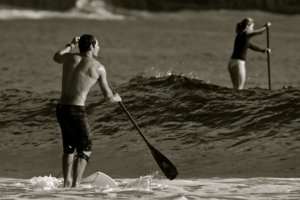- Staying away from dangers on the water. It’s very important that kids know that they should never paddle alone. Children should always paddle with a buddy so that always have access to assistance in case emergencies. Paddlers may need to be towed ashore.
Kid should always wear their flotation device. The most personal flotation device is an inflatable jacket that can be stowed away inside a fanny pack. Life jackets save lives. Stay with your leash. When paddling, a paddleboard is not only your child’s transportation but it is also an anchor. Paddlers should always wear ankle leashes when they venture off from the shores.

- Personal flotation devices. There are five types of PFDs. Offshore lifejackets, are very buoyant and are most suitable for every water condition, including rough and isolated water where your child’s rescue might be delayed. Although it can be bulky, the offshore jacket can turn unconscious individuals face-up. Buoyancy vests are best suited for calm water where a rescue can occur quickly. These aren’t designed for long periods in bad waters. And it is not able to turn every unconscious individual. Flotation aids are also for calm water where rescue can occur quickly. These are designed to keep the individual in their vertical position. However the child has to be able to turn themselves face-up. Type IV PFDs are mean to be thrown to conscious people while in the water. These are not to be worn. These can be thought of as life rings.Type Vs are designed for specific activities. They must be worn according to their specifications. This can even be in the form of a full body survival suit.
- How to kneel and paddle. The key to knee paddling is to stay low. The child must understand how to Keep the center of gravity very low, much like a cyclist. They should work to keep their body tight. If sitting too high, the child will not be reaching, which means they will be less stable.
- How to fall in the water (and not the board). Falling off of the paddle boards is virtually inevitable. It’s part of the fun. There is, however a right and wrong way of falling off. First, distance yourself from the board. Falling away from it will keep you out of harm’s way. You should also fall shallow, meaning, don’t dive in when the water isn’t very deep. Also, when you fall make sure that the paddle slices through the water and is not slapping it. This means that your blade or handle needs to be leading first.
- How to get back up on the board. Lead with your hand when you are resurfacing. When coming to the surface after falling,don’t lead with your head. This allows you to make sure that you’re coming up to the surface with a path that’s clear. When you are resurfacing, climb onto the board and stand at its center. The handle is an excellent indicator of the center point.
- How to Steer. Sure, steering around obstacles sounds easy but doing it well is another story. But there are a few tips to go by. You should focus on steering yourself clear of water-logged obstacles on the right by paddling on the right side of the board so that it will moves in the opposite directions. Also the sidestroke is the basic way to turn the board, and your child can master it very quickly by following a few rules. Slide the paddle into the water with a few strokes that are shorter and quicker than those you would use to propel yourself straight ahead. The child should also backpaddle. To backpaddle, you put your paddle in the water on the same side of your board as the direction of the desired turn and thenpull the blade of your paddle backwards. Just grip the paddle very tightly.
- The Best Strokes. There are several strokes available, however, the best and most popular is the Sea stroke. If you want to make a big turn, plant the paddle blade in the water towards the top, front of the board, and make a long stroke toward the very back of the board. Just as with the side stroke, this C-shape will turn you in an opposite direction of the side the paddle happens to be in the water. Making a giant C will make your board so some serious turns.
- If you lose your paddle. If you lose your paddle, you should make sure to remain calm. Do your best to spot a bouy in the water if possible. Once you have stabalized, call for help be calling out and waving an arm. However, if the child is an advanced swimmer, they can see the shore and the tide is not too high then they should swim back cautiously.
- Have Fun!! Seriously, teach your child to enjoy stand up paddleboarding and they will have a lifetime of fun ahead of them!
Photo Credit: Taro Taylor.